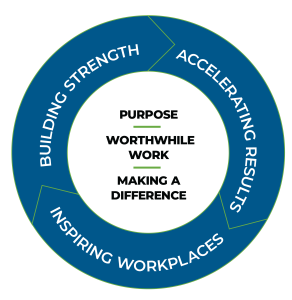
Creating the Momentum to Achieve Organizational Excellence in Education Systems
As any mechanic will tell you, the flywheel is critical to performance. The flywheel works by storing the energy created when the vehicle accelerates and then using that energy to keep the engine running smoothly when you let your foot off the gas pedal. Without the flywheel, the engine would sputter when you weren’t applying consistent pressure to the accelerator.
 Just like a van headed down the highway, any high-performing organization needs mechanisms in place that can keep things running smoothly during periods of transition or adjustment. Those mechanisms make up the Organizational Excellence Flywheel.
Just like a van headed down the highway, any high-performing organization needs mechanisms in place that can keep things running smoothly during periods of transition or adjustment. Those mechanisms make up the Organizational Excellence Flywheel.
The Organizational Excellence Flywheel represents the most resilient, highest-performing systems – the ones that simultaneously build strength in systems and people, accelerate results, and keep a steadfast focus on creating an inspiring workplace environment. It sounds straightforward, but in practice, it takes a great deal of leadership strength and continuous improvement effort to achieve.
Education Core Values: Purpose, Worthwhile Work, Making a Difference
In our two decades of coaching education systems in Organizational Excellence, we have found that the most common factor stopping their flywheel from spinning is the disconnect from the common set of values that drive people in the organization to create inertia.
Our approach to getting the Organizational Excellence Flywheel spinning in education systems is modeled on the belief that most people in education share a set of core values that drive them. They want to know that they have purpose, are doing worthwhile work, and are making a difference. When education leaders create environments that nurture these values, people in the organization are motivated to accelerate the system’s performance.
Inspiring Workplaces
Most people are called to be part of the education profession because they are passionate about what they do. Regardless of the position, they are motivated to help students succeed.
Educators are also trained to notice problems, focus on performance gaps, and react to failing systems. They are professionally trained to be problem identifiers. To a point this is good. They want to improve where there are gaps. However, constantly focusing on the negative shifts organizations away from a positive culture. We don’t suggest that they stop noticing what’s wrong. The goal is to substantially increase awareness of what’s right and intentionally celebrate and accelerate those actions.
There is much to celebrate in education. We see wins occurring in our partners’ schools, departments, and classrooms every day. Our book, Hardwiring Excellence in Education, focuses on tools and tactics we coach to reinforce and celebrate areas working well. The tactics are critical to creating the kind of organizational culture that spins the flywheel.
Creating inspiring workplaces starts with building a culture of gratitude. People have an inherent desire to feel valued by others. When leaders show gratitude, employees work harder and are more successful. Gratitude is an essential leadership skill that must be genuine, intentional, and frequent.
Making gratitude part of the culture is contagious. Showing appreciation toward someone often inspires that person to appreciate others. The culture of open appreciation will go a long way to keep morale positive when focusing on the uncomfortable phases of building strength – the next section of the flywheel.
Building Strength
Organizations are excellent because employees do excellent work. This section of the flywheel recognizes that leaders must build strength in their people to strengthen the system. That doesn’t occur naturally. Leaders must intentionally coach and develop people.
What’s the key to building strength in people?
- Communicate and demonstrate what is expected of employees.
- Genuinely care about their well-being.
- Listen and hear them.
- Recognize their successes.
- Provide feedback so they can improve.
- Give them opportunities to develop their skills.
- Challenge them to achieve beyond their expectations.
However, building strength doesn’t stop with employees. Without strong leadership practices, sustainable improvement will fail. We work with education systems to build leadership strength and capacity so that they can lead their organizations to achieve excellence. This work of building strength at all levels is what connects inspiring workplaces to the last section of the flywheel, accelerating results.
Accelerating Results
Positive results energize people to close performance gaps and stay on the winning side. We coach leaders in organizations to simultaneously celebrate wins and honestly assess areas for improvement. This balanced focus on what’s right builds the momentum the team needs to take on new challenges.
We coach leaders to have consistent check-ins on progress to results with continuous improvement conversations where teams focus on applying strategies that move the organization forward. We apply an Evidence-Based Leadership model that empowers leaders to make informed decisions and test assumptions using data. When results slow or decline, we coach leaders to engage teams in conversations about why the downturn is occurring and ways to improve.
All the while, people become more and more engaged in achieving the organizational goals. They see how what they do matters and are actively involved in the pursuit of excellence.
KEY TAKEAWAYS
Think differently.
Recognizing and nurturing shared core values, such as purpose, worthwhile work, and making a difference, among educators is pivotal for initiating and sustaining momentum towards organizational excellence in education systems.
Plan differently.
Building an inspiring workplace culture involves deliberately shifting attention towards celebrating achievements rather than solely pinpointing challenges, fostering a culture of gratitude and recognition that not only enhances morale but also cultivates a positive atmosphere conducive to continuous growth and improvement.
Act differently.
To strengthen the organization and its people, leaders must clearly communicate expectations, demonstrate care, provide feedback, and offer development opportunities. By embracing a culture of celebrating wins, honest assessment, and evidence-based decision-making, teams can expedite results and sustain momentum toward organizational excellence.




